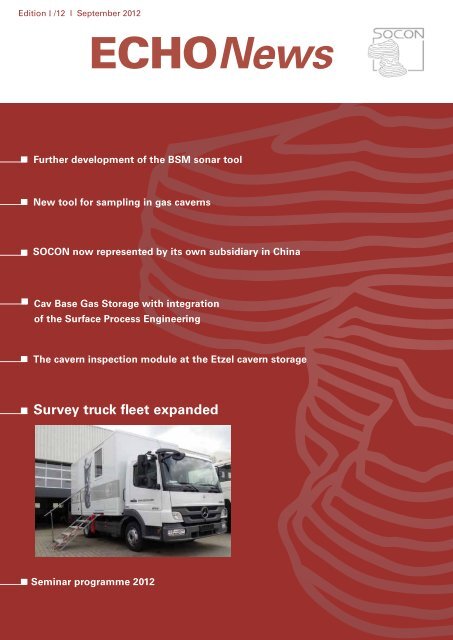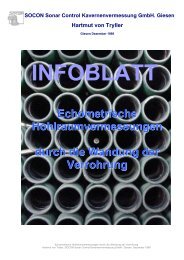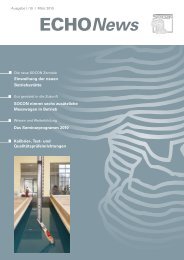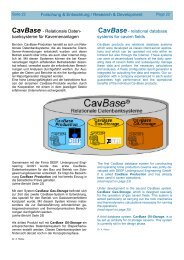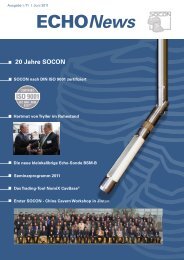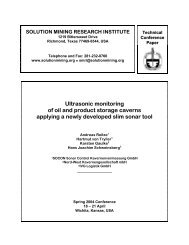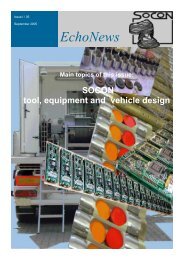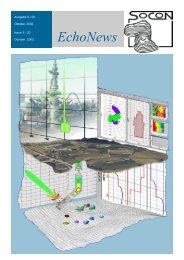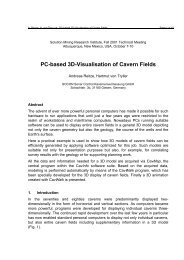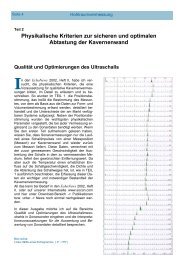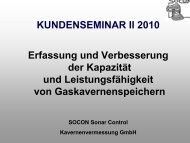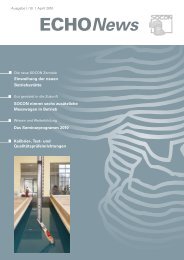ECHO NEWS - Edition I - September 2012 - SOCON Sonar Control ...
ECHO NEWS - Edition I - September 2012 - SOCON Sonar Control ...
ECHO NEWS - Edition I - September 2012 - SOCON Sonar Control ...
You also want an ePaper? Increase the reach of your titles
YUMPU automatically turns print PDFs into web optimized ePapers that Google loves.
CavVibration - The new software developed by <strong>SOCON</strong> visualises and archives the data acquired by the accelerometers.The data are saved on two independent2GB capacity SD memory cards (redundantstorage), which allows 60 milliondatasets to be stored - at a sampling rateof 100ms this corresponds to a period of70 days.The sampling times are controlled byan exceptionally stable, temperaturecompensatedquartz oscillator with amaximum drift of +/- 3ppm over the operatingtemperature range of 0 to +80°C.The stored data can be read during the recordingoperations via the <strong>SOCON</strong> standardinterface DIN measurement bus. Ata sampling rate of 100ms it is possible toread the data online without any time delay.Specially developed for this newsystem, has the following features:• Survey campaigns and the resultsobtained are managed in a projectstructure,• Tabular and graphic visualisationof the survey results,• Online monitoring of the sensorsas well as simultaneous transferof the recorded results during surveyoperations,• Offline reading of results via ethernetinterface• CSV-export of survey values.Hajo David and Stefan FrankeOffline (at the surface) the data fromthe VMS tool can be read via ethernetat an even faster data transfer rate. Positioningof the tool and the clampingarrangement in the casing is carried out,similar to that of the SoMIT tool, usingthe <strong>SOCON</strong> CavLog standard software.One of the VMS circuit board in detail view.7
Tying in the Underground Thermodynamic Simulation of GasStorage Caverns with the Surface Process EngineeringPaper presented at the SMRI fall meeting <strong>2012</strong> in Bremen, Germany. Authors: Dr Michael Krieter, Stefan Wieber-Klocke, André Stille (<strong>SOCON</strong> <strong>Sonar</strong> <strong>Control</strong> Kavernenvermessung GmbH), Jochen Kemper (OGE, Open GridEurope GmbH, Essen), Dr Katrin Vosbeck (EGS, E.ON Gas Storage GmbH, Essen)AbstractCommissioned by EGS and in cooperationwith EGS and OGE, <strong>SOCON</strong> has developeda software package that extendsthe CavBase Gas Storage software byincluding features for the above groundfacilities. This software, which can alsobe used independently of the cavernsoftware, enables pressure and temperaturecalculations to be made from thecavern head all the way to gas transportpipelines. In doing this the various individualcomponents are considered, forinstance the station piping, separators,boilers, heat exchangers, pressure reductionstreams , compressors, coolers,gas drying units and meter streams. Heatexchanger, boiler and compressor capacitiesare likewise indicated. In additionthe calculations reveal how many heatexchanger and compressor componentsare needed for a planned gas nomination.Nominations are made on an hourly basisand assimilated by the NomiX softwarecreated by GreyLogix GmbH. The datais then made available to CavBase. Theentire CavBase system is embedded inNomiX and its purpose is to provide a rapidthermodynamic and rock mechanicscheck of the gas nominations to enablepermanent online access to the informationon capacity and availability of thecavern storage. The system has been implementedin the EGS’s Holford gas storage.Installation and initial tests of thesoftware were carried out and assessedin May/June <strong>2012</strong>.IntroductionOn the basis of the know-how withinthe companies <strong>SOCON</strong>, OGE, EGS andGreyLogix, the software – entitled NomiX[1] – can precisely predict the feasibilityof gas quantity nominations with regardsto the rock mechanics, thermodynamicsFig. 1: Principle of the NomiX structure (Brodersen et al)and specifics of the installation and make … numerically simulates the abovethis information available to the gas traderand station manager (Fig. 1). As the surface situation as authentically asground facilities and images theprocedure can be performed if required possible,within just one hour, NomiX moreover … creates a link-up with the cavernpromotes the reliable and economic multicyclicoperation of storage caverns. Storage,simulation program CavBase Gas… continuously reads the current stateHowever, the fact that traders are constantlyrequiring better prediction accura-system andof storage from the process controlcy has made it necessary to integrate the … considers the availability of theprocess engineering system into the predictionsimulations (subsurface and sur-the maintenance intervals.components of the installation andface). This is because the availability anddesign limits of the system components The simulation software is like the entirestorage system divided into differenthave a significant effect on the performance(capacity and deliverability) of the processing sections. During injection,gas storage. The number of compressors withdrawal and standstill the followingneeded for injection or gas drying units elements are taken into account:needed during withdrawal as well as anexact description of the conditions at the Underground:different process sections within the stationare predicted by the algorithm that rock as well as the production casing.The caverns and the surrounding salthas been created.At the surface:On behalf of and in cooperation with EGS Inlet separators, heat exchangers,and OGE, <strong>SOCON</strong> has developed new boilers, pressure reduction streams,software that, based on planned nominationsof gas or energy quantities, streams, pipelinegas drying units, compressors, meternetwork.8
Operations were started in the Holfordgas storage in November 2011. It waspossible from the end of June <strong>2012</strong> to implementand test the NomiX system togetherwith the surface and undergroundcomponents of the CavBase Gas Storagesoftware. The first comparisons betweenthe measured values and the simulationresults have already been made and arepresented here. As cavern simulationusing CavBase Gas Storage has alreadybeen described in detail at previousSMRI meetings [2], [3], we have in thispaper restricted ourselves to a presentationof the results of the surface calculationsand the measured operational data Fig. 2: Simulation and modeling of the underground an above ground facilities by CavBase GasFig. 2: Simulation and modeling of the underground and above ground facilities by CavBase Gas StorageStorage integrated in NomiX (Fig. 1)(gas pressures, temperatures, energies) integrated in NomiX (Fig. 1).vern is lower than the defined transmissionpipeline pressure during withdrawal. for the compressor usage. If (Δh scombination of values must be foundOperations were started in the Holford gas storage in November 2011. It was possible from the end ofDue to the short operation time and, q b) isJune <strong>2012</strong> to implement and test the NomiX system together with the surface and undergroundtherefore a small amount of operational components During injection of the CavBase and withdrawal Gas Storage the software. characteristicThe outside first comparisons the reference between field the measured number values ofand the simulation results have already been made and are presented here. As cavern simulation usingdata available the software has not yetCavBase Gas Storagebehaviourhas alreadyof thebeencompressordescribed incompressorsdetail at previousisSMRIincreasedmeetingsor the[2],boundarythe of the results field of is the searched surface calculations (by increasing and the[3], we havebeen optimised and calibrated. Furthermorethe following presentation of thethe Δp across the compressor throughin this [4] must paper be restricted taken ourselves into consideration. to a presentation ofmeasured operational data (gas pressures, temperatures, energies)results acquired till now should therefore Due The to the behaviour short operation is defined time and by therefore a reference a small the amount discharge of operational throttling data available valve or the increasingaspects. flow through the compressor bysoftwarehas not During yet been injection optimised and calibrated. withdrawal Furthermore characteristic the following presentation behaviour of the of results the acquired compressobe considered in light of these aspects. till now field. should With therefore reference be considered field in the light isentropicdegree of efficiency can be taken opening the recycling valve). Additionalof theseconsideration.Main components of the above ground facilitiesMain components of the from The the behaviour operating is flow defined volume by a q referenceband compressors field. With can the decrease reference the operating field the isentropabove ground facilities Pipeline the can isentropic network be taken enthalpy from difference the operating Δh flowsflow volume volume q b and through the isentropic each compressor enthalpy differThe pressure and temperature losses are calculated using a modified Darcy-Weisbach equation. Tocalculate the factors affecting the volume flow, which and is significant lead especially to a new for position the dimensioning in the referenceof thePipeline networkpipelines (given the volume flow, and looking for the input andfield.output pressure),the Darcy-Weisbachequation can be converted using the Bernoulli and general gas equation. The temperatures are estimatedThe pressure and temperature losses using the Joule-Thomson coefficients.are calculated using a modified Darcy-4. The coupling power can be calculatedwith level the so results as to enable of step the 3. injection It must andThe compressorsWeisbach equation. To calculate the fac-Thtors affecting the volume flow, which isbe taken into account that the couplingcompressor may be necessary to raise the pressurewithdrawal process to be performed. This is the case when the pressure in the cavern is too high duringinjection or when the pressure in the cavern is lower than the defined transmission pipeline pressuresignificant especially for the dimensio-durinning of the pipelines (given the volumeavailable motor power (Holford has elec-withdrawal.power must be smaller than the maximalFig 3. The determination of the isentropicflow, and looking for the input and outputtric motor driven compressors) whichreference fieldpressure),the Darcy-Weisbach equation3 depends upon the compressor speed. Incan be converted using the Bernoulli andthis case the number of compressors isgeneral gas equation. The temperatures Fig 3. The determination of the isentropic degree of found and the coupling power is known.efficience by a reference fieldare estimated using the Joule-ThomsonThe compressor calculation can now be summarised as follows:coefficients.The algorithm can take several compressorsThe1.compressorCalculate thecalculationenthalpycandifferencenowh s usinginto account.the underlyingIf it cannotgasfindconstantsa solutionthe injection and withdrawal process2. Get the operating volumetric flow q bThe compressorsbe summarised as follows:3. Determine the isentropic efficiency by the use of the reference field.The compressor may be necessary to 1. Calculate the enthalpy difference Δh scannot be performed under the givenraise the pressure level so as to enable As using the the reference underlying field gas is constants limited a valid conditions. combination The rejected of values nomination must be is returnedthe number to the NomiX of compressors system. In case is increased of a orfound forthe injection and withdrawal process to 2. ( Get h s , the q b ) operating is outside volumetric the reference flow q bfieldbe performed. This is the case when the 3. is Determine searched the (by isentropic increasing efficiency the p solution across the the number compressor of compressors through and the dischpressure in the cavern is too high during increasing by the use of flow the reference through the field. compressor the necessary by opening coupling the power recycling is returned valve). Addinjection or when the pressure in the ca-Asdecreasethe referencethefieldoperatingis limitedflowa validvolume through each compressor and can leadto NomiX.reference field.4. The coupling power can be calculated with the results of step 3. It must be tacoupling power must be smaller than the maximal available motor power (Hodriven compressors) which depends upon the compressor speed. In this 9 case theis found and the coupling power is known.
The gas drying unit (GDU)When gas flows through the GDU thepressure and temperature is reduced.The pressure drop depends upon the volumetricflow and real values are used forthe calibration. For a given rate the pressuredrop can be interpolated by a spline.A „good“ approximation is yielded froma large number of accurate measured valuesand provides a „reasonable“ assessmentof the pressure drop. When multipleGDU‘s are working in parallel the gasstream is split in line with the number ofused GDU’s. The volumetric flow leads toa smaller pressure drop.The pressure reduction stream andheat exchangerIf the combined cavern pressure comparedto the transmission pipeline (nationalgrid) pressure is very high, thenthe pressure is reduced to the pressurewhich is necessary to transfer the gasinto the transmission pipeline plus pressurelosses in the station piping and themeter streams. The heat exchanger hasthe job of raising the gas temperature toachieve a minimum temperature of 18°Cdownstream the pressure reduction station.Temperatures are generally calculatedusing the Joule-Thomson algorithm.The calculations have been taken fromthe worksheet G499 published by theGerman Technical Association for Gasand Water (DVGW) [5].Possible scenarios during injection /withdrawalEssentially four cases can be differentiatedin the calculations for the aboveground procedures:1. Withdrawal without compression2. Withdrawal with compression3. Injection without compression4. Injection with compressionBy way of example case 1 is describedin more detail. The procedures and cal-Fig.4: Flow chart for the situation: Withdrawal without compressionculation routes with the individual componentsare summarised in Fig.4. Thecircled numbers (x) in the figure indicatethe order of the calculations. The dynamicinput data is: Cavern head pressuresfor three caverns, total flow volume aswell as pressure and temperature in thetransmission pipeline (national grid).low and /or the gas temperature is high,the 18°C temperature will be achievedwithout heaters so they will not be usedin the simulation. In order to decide if acompressor must be used the simulationcalculates the pressure loss from thenational grid to point (3). This is done bya retrograde simulation of the pressureand temperature losses that occur fromProcedure for case 1:Withdrawal without compressionthe national grid via the meter streams(4), the station piping (5), the gas dryingunits (6) and up to just before the heatPressure and temperature losses in thefield pipelines from the cavern heads tothe manifold (1) up to the inlet separators(2) are calculated. Pressure and temperatureafter the separators and before theheat exchangers as well as the pressurereduction streams are determined (3). Atthis point the simulation result defineswhether withdrawal is to take place withor without a compressor. If withdrawalcan be done without a compressor thengenerally the pressure must be reducedand the heaters must raise the temperatureof the gas so that after the pressurereduction it is equal to or higher thanexchangers (7). Points (4) to (7) do not representflow paths but rather calculationpaths. The 7.2 MPa pressure at point (7)is about 0.6 MPa less than the pressureat point (3), where it is 7.8 MPa. This meanswithdrawal can take place withoutrecompression, but pressure reductionis needed. The heat exchanger need notto be used because the downstreamtemperature due to pressure reduction(8) is more than 11.92 K above 301.15K (setpoint temperature). The pressureand temperature losses in the stationpiping (11) and in the meter stream(12) indicate a pressure of 7 MPa at the18°C or 301.15°K. If the pressure drop is transmission pipeline (national grid).10
The output parameters of thesecalculations are:1. Pressure and temperature valuesat every relevant component2. Number of heat exchangers3. If heat exchangers are needed thenthe required boiler energy4. Number of compressors5. If compressors are needed thenthe required compressor powerExamplesPressuresA two month period was evaluated. Thehead pressures of the three cavernsand the absolute total volume rates areshown in figure 5. Calculated and measuredpressures before the inlet separators,after the gas drying unit and afterthe meter streams are shown in the nextthree figures. For comparison the transmissionpipeline pressure (national grid)is additionally shown in fig.6 and fig.8.TimeFig.5: Wellhead pressures of three test caverns in relation to the total volume rateThe results in the figures show that thepressure calculation for individual componentswas very successful for thefirst comparison between measured andcalculated values. It can certainly be expectedthat the data will be improved byfurther calibration of the individual componentsbased on operational data coveringa wider range of system pressuresand production rates.TimeFig.6: Calculated and measured pressures just before the inlet separators(point (2) in Fig.4) and the transmission pipeline pressure (measured).TemperaturesThe temperature (Fig. 9) calculations donot yet exhibit agreement similar to thatof the pressure data. Indications of thelarge temperature differences point towardsthe Joule-Thomson coefficient.However, this has still to be verified.Compressor powerThe power of two compressors is shownin the following figure for a brief stabilisedcomparison period. The comparisonbetween the measured and calculatedTimeFig.7: Calculated and measured pressures after GDU (point (10) in Fig.4).11
values reveals that the chosen approachfor calculating using reference fields wasthe right one. However, similar to all theother components, here too a suitableadjustment must still be made.TimeFig.8: Calculated and measured pressures after meter streams (point (12) in Fig.4).ConclusionsIn a first step it has been possible tosuccessfully integrate the process equipment,compressors and field piping of acavern gas storage facility (Holford storageoperated by E.ON Gas Storage). Ofall the relevant parameters it is the pressurebehaviour in the whole system thatcould be predicted the best. For all parameters,such as pressure, temperature,compressor capacity and boiler energy,there is still a need for further calibration.In other words certain quantities, such asthe pipe friction factor, Joule-Thomsoncoefficient and compressor referencefields, must in terms of their values or algorithmsbe better adjusted to fit the realmeasured values. obtained only from differentand stable gas storage operationwith different volume flow rates at differentpressure and temperature levels.Dr. Michael KrieterTimeFig.9: Calculated and measured temperatures just before the inlet separators (point (2) in Fig.4).TimeFig.10: Calculated and measured compressor capacitiesReferences[1] Brodersen, F., Vosbeck, K., Kemper, J.,NomiX,A solution to focus on sales-related questionswithout disregard of cavern restrictions, SolutionMining Research Institute ,Fall <strong>2012</strong>, TechnicalConference, Bremen, Germany.[2] Krieter, M., Reitze, A., von Tryller, H., The Developmentof Natural Gas Caverns as a TradingTool and the Consequences, SMRI Fall MeetingLeipzig, Germany, 2010.[3] Dresen, R.: Advanced Systematic Determinationof Underground Gas Storage Salt CavernCapacities, SMRI Fall Meeting. Leipzig,Germa ny, 2010.[4] Dietzel, F. 1981, Turbinen, Pumpen und Verdichter,Vogel Verlag,ISBN 3-8023-0130-7[5] DVGW Arbeitsblatt G499 „Ergas Vorwärmung inGasanlagen“, 200712
Mining surveying - more than just mine mapsPrediction of ground movements gaining importanceThe range of services offered by <strong>SOCON</strong><strong>Sonar</strong> <strong>Control</strong> KavernenvermessungGmbH in the area of mining surveying coversnot only the preparation of the minemaps for cavern fields in accordance withGerman Mining Law, but also surface levellingand all other mining surveying andgeodetic surveys as well as the predictionof ground movements.The computer-aided information systemKARISDAT (= cavern maps on the basisof a database), developed by <strong>SOCON</strong>, isat hand for carrying out the mine surveyingwork efficiently and in a way to meetfuture requirements. It is based on Auto-CAD and is approved by the mining authoritiesfor generating maps by computer.As a result of its consistent further developmentKARISDAT has matured into ahigh performance system that has areasof application which go well beyond thepreparation of the legally required mineplans. For instance, it is possible to makea wide range of interpretations and cartographicdisplays of the underground andsurface situation as well as location mapsfor mining authorisation in accordancewith German mining law.The KARISDAT-SUB module enables theground movement expected to occurabove cavern fields to be predicted. Suchpredictions are based on the influencingfunctions, whereby the parameters needed(e.g. the limit angle, specific cavernconvergence and so on) can be deriveddirectly from the KARISDAT database.Besides subsidence it is possible to predictground movement aspects such astilting, curvature, horizontal displacementas well as compression and extension.Available for GIS applications (GeographicInformation System) is KARISDAT-GIS, amodule which builds on Autodesk Civil3D, an AutoCAD-based product for creatingprofessional GIS systems. Using thismodule our Software Development teamor the user himself can prepare specificGIS applications. Interesting and usefulapplications in this respect can be derivedin particular on the basis of pipelinesshown in the mining plans as well as byintegrating the automated land registrationmaps (ALK) and the automated landregister (ALB) and/or data of the officialland registry information system (ALKIS).Dr Andreas Reitze13
In brief • International activities<strong>SOCON</strong> now represented by its own subsidiary in ChinaSubsequent to highly constructive negotiationswith our Chinese partner, ChinaSalt Jintan Co. Ltd., we signed a contractfor establishing a joint venture companyin China at the end of 2011. The new,legally independent company is called<strong>SOCON</strong> Cavern Services Co. Ltd. and isbased in Jintan in the Jiangsu province,near the existing cavern fields and thosecurrently being created. It is worthmentioning that <strong>SOCON</strong> <strong>Sonar</strong> <strong>Control</strong>Kavernenvermessung GmbH has anmajority stake in this company. Such amajority holding by a foreign companyin a Chinese company became possibleonly recently.Present at the signing of the contractwere not only high ranking officials ofChina Salt from Peking, but also the mayorof the city of Jintan, the chairmanof the local trade supervisory authorityCity of Jintan as well as some 100 otherguests. This underlines the importance ofthe founding of this company for China,especially with a view to the constantlygrowing cavern industry.Having a subsidiary in China will nowmake it easier to efficiently plan and carryout surveying services at short noticeFrom the left: Vice President Mr Feng (ChinaSalt), Prof Liang, University Nanjing, mid Mr Ya Chiang, Tradesupervisory authority City of Jintan, Mr Hartmut von Tryller and Zhenhe Ma (<strong>SOCON</strong>) and bothcompany presidents Mr Guan and Dr Andreas Reitze during ceremony of contract signature.for our customers under the prevailingconditions there. Moreover there will nolonger be any need to constantly importand export the survey equipment, whichis a time and cost intensive undertaking.The first two Chinese employees have alreadybeen hired and are being suitablytrained. Besides carrying out cavern surveys,the cavern monitoring systems previouslysold to Chinese customers will infuture also be serviced and maintainedfrom the base in Jintan.Dr Andreas ReitzeFurther cavern surveying system delivered to ChinaA full cavern surveying system completewith BSF II tools could be suppliedon time to another customer in Chinain summer <strong>2012</strong>. The initial training withthe new sonar tools and the CavScansurvey systems has already taken place inour headquarters in Emmerke, Germany.Xiaochao Sun (left) and Bin Wang (in the background)during a training session with the CavScansurvey equipment from <strong>SOCON</strong> supported byDr Zhenhe Ma and Joerg Burmester.14
In brief • InternalsNew employees in Survey Engineering and Software DevelopmentOur employees are our most importantasset. Thats why we are especiallypleased to be able to welcome anothertwo new employees to our team:Stefan Franke has joined the ranks ofour Software and Development departmentin Giesen as a program developer.Mr Franke started work at <strong>SOCON</strong> on1 December 2011 and is already involvedin several development projects. He programmedthe Windows ® Cav VibrationSoftware for the new Vibration MonitoringSystem.To support our field office in WiesmoorMr Joern Dueselder joined <strong>SOCON</strong> onMr Stefan Franke (Software development)1 August <strong>2012</strong> as a survey technician. MrDueselder has already accompanied numeroussurvey operations and will be initiatedstep by step into the secrets of oursurveying technology. We wish both ourMr Joern Dueselder (Survey technician)new employees every success for theirfuture at <strong>SOCON</strong> and are looking forwardto their energetic support.Oliver Busjahn<strong>SOCON</strong> provides training recognised by the local Chamber of Industry and CommerceA bouquet of flowers for the new generation: A fitting reception for Patrick Dettmer, our first apprenticeSubsequent to an assessment carriedout by the Chamber of Industry and CommerceHannover, <strong>SOCON</strong> <strong>Sonar</strong> <strong>Control</strong>Kavernenvermessung GmbH was grantedcompany recognition in February<strong>2012</strong> to train its own apprentices. In thisconnection quite a few applicants repliedto the advertisement for a position as apprenticeelectronics technician for equipmentand systems. After shortlisting themost promising candidates these wereinvited to take an aptitude test. On thebasis of the test results as well as personaltalks with the applicants a decisionwas made in favour of Patrick Dettmerfor the position. Mr Dettmer started histraining on 3 <strong>September</strong> <strong>2012</strong> and in thefirst place was assigned to the Tool Constructiondepartment.Karl-Heinz Knospe15
Downwards -With the CavLift on an subterranean journeyThe cavern inspection module at the Etzel cavern storageAs announced in our last issue, constructionof <strong>SOCON</strong>‘s cavern hoist systemCavLift has now been completed - themaiden voyage took place back in <strong>September</strong>2011. On the open day at thecavern storage in Etzel, CavLift gave visitorsthe opportunity to take a virtual lookinside the huge cavern storage complex.Many of the visitors, most of whom werefamiliar with the locality, acquired an ideaof the dimensions of a cavern field for thefirst time in their lives. CavLift proved tobe an absolute highlight the first time itoperated. In the tent set up next to theCavLift visitors were kitted out with hardhats, lifesavers and sick bags before startingout on their 13-minute undergroundjourney. Biscuits were offered to the waitingpassengers to alleviate any uneasinessand a safety film was shown to getthem in the mood for the cavern trip. Theexcitement could be seen in the faces ofmany of the visitors, after all the rumourwas being spread that everyone wouldreally be going underground in the greencontainer.Subsequent to Hartmut von Tryller‘s extensivepreliminary planning, the CavLiftwas completed in <strong>September</strong> 2011 andsince then has been regularly travellingunderground at our headquarters. Thesolid interior and a programme individuallyadapted to suit the customer createsexactly the right atmosphere. CavLift isnot a classic fairground ride, yet the setupimpressively conveys the storageprinciple and the dimensions of a cavernwhen it is operated at trade fairs and forpublic relations work arranged by cavernoperators.Scenes from the journey„The transport container for this adventuretrip in an old, disused and somewhatrickety <strong>SOCON</strong> shaft cage - whateverthat involves and whatever risks are potentiallyconnected with this.“ Indeed,these were the words with which MarcelReich-Ranicki (a famous literary critic), aliasGerald Kollek, greeted the passengersbefore setting out. And of course NorbertBluem (a former German politician)also had to have his say before finally theacoustic attendants - Sarah Sorgenreich(Sarah Full-of-worries) and Klaus Ohnesorge(Klaus No-Worries) - welcomed16
the travellers and informed them in depthabout the dangers of a cavern excursion.In the meantime the <strong>SOCON</strong> employeestook care of the final maintenance workon the CavLift - rigorously cleaning, hammeringand adjusting. On completion ofthe maintenance work the support cablewas hooked up and then it was off onthe downward journey. Straight away thecabin announcements informed the passengersabout the rock layers and at whatdepth they were. A journey of discoverystarted through an immense subterraneanstorage with numerous caverns, andone of them was passed through on agentle trip from the floor to the roof. Thissection illustrated in particular the sheervastness of a cavern and for the first timemade it possible to appreciate the spatialresult of years of leaching work that<strong>SOCON</strong> measures and interprets.Then, after giving a final overview of thewhole cavern complex, the return journeystarted back up to the base station,where the next set of passengers werealready waiting, with knees trembling,for their turn. As a souvenir every visitorcould take home a new, folded sick bagwith the word „Glueckauf“ (a miners‘saying for Good Luck) written on it, becausehappily during the first trouble-freeCavLift run none of the bags had to beused.The origin of a virtual tour into subterranean worldsCavLift can be operated at public events,trade fairs and meetings either using theon-site electricity and compressed air installationsor completely self-contained.Any cavern can be inspected on a virtualtrip depending on the current state of development.The lattice model of the cavernstorage is reworked and rendered asa film sequence, then the motion of theanimation is synchronised with the controlelectronics of the CavLift and transferredto the container through pneumaticoperated cylinders. A trip through acavern generally lasts about 10 minutes.An extensive underground sound archiveis integrated into the production and, incooperation with the customer, is adjustedin detail to fit in with the overall picture.For instance, the passage throughdifferent rock layers and formations,along the cavern wall and down to thebrine-filled floor. The visualisation of thetrip in the shaft cage is modelled completelyin three dimensions, textured using aspecial software, illuminated and specialeffects are added. If required a stereoscopicdisplay of the cavern tour can becreated. Naturally any customers interestedhave the opportunity of making a testtour on the <strong>SOCON</strong> premises.Christian Hartlep17
Customer seminars at <strong>SOCON</strong>Ever since the company was establishedback in 1991, <strong>SOCON</strong> <strong>Sonar</strong> <strong>Control</strong>Kavernenvermessung GmbH has withinthe framework of its service offeringpresented itself as a communicationcentre for the representatives of cavernoperators and mining authorities as wellas for engineers, technicians and allthose interested in the various aspectsassociated with caverns. Over the yearswe have regularly held events andseminars revolving above all around themany subjects of Caverns and Cavities.Talks at the meetings have ranged fromthe sonar monitoring of caverns andgeophysical survey methods to todaystasks in cavern construction and operation,and to the presentation of the latestsoftware developments by the various<strong>SOCON</strong> departments. Furthermore seminarshave been organised on specialtopics of mining surveying and GSOS(Gas Storage Optimisation & Service) aswell as excursions arranged with visitsto mines and caverns. Lectures are givenin the usual way with no strict order.During the breaks there is plenty of timefor participants to discuss topics, makenew contacts and exchange ideas. Andof course our employees are on hand toanswer any questions or provide a guidedtour of our premises.We are already looking forward to theupcoming seminars and to welcomingyou here!Outlook to 2013Most probably <strong>SOCON</strong> will offer once again a 4-day exkursion to Bavariaand Austria in May 2013. This tour will include a trip into leached caverns.As soon as the exact date is known we will inform in a newsletter and ourhomepage www.socon.com about it.18
Seminar programme <strong>2012</strong> - held in germanScheduleSeminar I / <strong>2012</strong>Thursday 20 <strong>September</strong> <strong>2012</strong>Cavern surveys as a basis for rockmechanics calculations and modelling10:00 hrs Begrüßung und Einführung(Dr Andreas Reitze)10:15 hrs Echometrische Kavernenvermessungenals Basis für gebirgsmechanischeBerechnungen(M.Sc. Timo Stahl, <strong>SOCON</strong> <strong>Sonar</strong><strong>Control</strong> Kavernenvermessung GmbH)10:45 hrs Besonderheiten von <strong>Sonar</strong>vermessungenin der Kaverne SCH1 / Österreich(Dipl. Geophys. Frank Haßelkus,<strong>SOCON</strong> <strong>Sonar</strong> <strong>Control</strong>Kavernenvermessung GmbH)11:15 - 11:30 hrs Coffee break11:30 hrs Dreidimensionale, dynamischegeomechanische Modellierung einesSolkavernenfeldes unter Verwendungechometrischer Vermessungsdaten12:45 - 14:00 hrs Lunch breakGemeinschaftsvortrag:Dr Stefan KellerbauerGeologie und Geotechnik,Reinhard Hubermüller+hereth, Ingenieurbüro fürTunnel und Bergbau GmbH,Dr Lothar te KampItasca Consultants GmbH14:00 hrs Von der Vermessung zur gebirgsmechanischenModellierung und Interpretation(Dr Dirk Zander-Schiebenhoefer,KBB Underground Technologies GmbH)14:45 hrs 3D-Analyse von Kavernenvermessungenzur Ermittlung teufenabhängigerKonvergenz(Dr Michael Krieter, Dr Zhenhe Ma,<strong>SOCON</strong> <strong>Sonar</strong> <strong>Control</strong>Kavernenvermessung GmbH)15:30 hrs End of seminar / CoffeeSeminar II / <strong>2012</strong>Thursday 22 November <strong>2012</strong>Effects of the energy transition on the construction andoperation of storage caverns and the significance of this10:00 hrs Begrüßung und Einführung(Dr Andreas Reitze)10:15 hrs Power-2-Gas: Zukünftige Nutzung vonGaskavernen und Umwandlung gasförmigerMedien in elektrische Energie(Fritz Crotogino, KBB UndergroundTechnologies GmbH)11:00 hrs Vorstellung des InformationssystemsSalzstrukturen zur Speicherung von erneuerbarenEnergien (InSpEE-Projekt)(Stephanie Fleig, Bundesanstalt fürGeowissenschaften und Rohstoffe)11:15 - 11:30 hrs Coffee break11:30 hrs Untertage Pumpspeicherung (UPS)mittels Sole und Druckluft(Dr Wolfgang Littmann, ConsultingReservoir Engineering)12:15 hrs Besonderheiten echometrischerHohlraumvermessungen in gasförmigenMedien wie CH 4, N 2und H 2(Dr Andreas Reitze, Frank Haßelkus,<strong>SOCON</strong> <strong>Sonar</strong> <strong>Control</strong>Kavernenvermessung GmbH)12:45 - 14:00 hrs Lunch break14:00 hrs Permanente Verfahren für BohrungsundKavernenmonitoring zur Überwachungund Optimierung des intensiviertenSpeicherbetriebs(Dr Ralph Dresen, Well IntegrityServices Engineering)14:45 hrs Schädigungs- und Verheilungseffektebei der zyklischen Belastung von Steinsalzund ihre Berücksichtigung bei derTragwerksanalyse von Gaskavernen(Priv.-Doz. Dr Uwe Düsterloh,Technische Universität Clausthal)15:30 hrs End of seminar / CoffeeDeadline of registrations 7 <strong>September</strong> <strong>2012</strong>Seminar fee: 90 EUR, + VAT.Deadline of registrations 9 November <strong>2012</strong>Seminar fee: 90 EUR, + VAT.REGISTRATION: Please send us your binding written application to register indicating the code `<strong>SOCON</strong>-Seminar */<strong>2012</strong>` with the name of the person in your companywho will taking part. Upon receipt of your applications we will send you confirmation of your registration. Applications will be considered strictly in the orderthey are received. VENUE: <strong>SOCON</strong> <strong>Sonar</strong> <strong>Control</strong> head offices • Kavernenvermessung GmbH • Windmühlenstr. 41 • 31180 Giesen OT Emmerke / GERMANY19
Echometric surveying with sonar andlaser systems in liquid and gaseous mediaContinuous interface, pressure and temperature recordingfor impermeability tests (SoMIT technique)Determination of interfaces using impuls-neutrongammaand gamma-gamma measurementsRecording of physical parametersas well as sampling in liquids and gas3D visualisation and animationMine surveying and measurements, updating ofmine plans and forecast of ground movementsScientific consulting and software foroptimising underground gas storageHardware and software developmentaccording to customer specificationsSeminars and training<strong>ECHO</strong>News<strong>SOCON</strong>Publisher:<strong>SOCON</strong> <strong>Sonar</strong> <strong>Control</strong>Kavernenvermessung GmbHWindmühlenstrasse 4131180 Giesen OT Emmerke / GERMANYTel.: +49 5121 998 19 - 0Fax.:+49 5121 998 19 - 88info@socon.comwww.socon.comEditorial staff:Dr Andreas ReitzeFrank HaßelkusComposition:Christian HartlepAuthors:Oliver BusjahnHajo DavidHenning EngelkeStefan FrankeKlaus-Jürgen GotthardtChristian HartlepKarl-Heinz KnospeDr Michael Krieter


